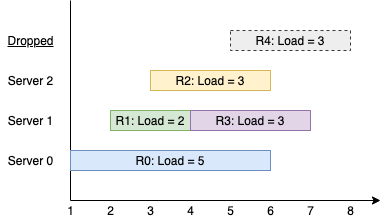You have k servers numbered from 0 to k-1 that are being used to handle multiple requests simultaneously. Each server has infinite computational capacity but cannot handle more than one request at a time. The requests are assigned to servers according to a specific algorithm:
- The
ith(0-indexed) request arrives. - If all servers are busy, the request is dropped (not handled at all).
- If the
(i % k)thserver is available, assign the request to that server. - Otherwise, assign the request to the next available server (wrapping around the list of servers and starting from 0 if necessary). For example, if the
ithserver is busy, try to assign the request to the(i+1)thserver, then the(i+2)thserver, and so on.
You are given a strictly increasing array arrival of positive integers, where arrival[i] represents the arrival time of the ith request, and another array load, where load[i] represents the load of the ith request (the time it takes to complete). Your goal is to find the busiest server(s). A server is considered busiest if it handled the most number of requests successfully among all the servers.
Return a list containing the IDs (0-indexed) of the busiest server(s). You may return the IDs in any order.
Example 1:

Input: k = 3, arrival = [1,2,3,4,5], load = [5,2,3,3,3] Output: [1] Explanation: All of the servers start out available. The first 3 requests are handled by the first 3 servers in order. Request 3 comes in. Server 0 is busy, so it's assigned to the next available server, which is 1. Request 4 comes in. It cannot be handled since all servers are busy, so it is dropped. Servers 0 and 2 handled one request each, while server 1 handled two requests. Hence server 1 is the busiest server.
Example 2:
Input: k = 3, arrival = [1,2,3,4], load = [1,2,1,2] Output: [0] Explanation: The first 3 requests are handled by first 3 servers. Request 3 comes in. It is handled by server 0 since the server is available. Server 0 handled two requests, while servers 1 and 2 handled one request each. Hence server 0 is the busiest server.
Example 3:
Input: k = 3, arrival = [1,2,3], load = [10,12,11] Output: [0,1,2] Explanation: Each server handles a single request, so they are all considered the busiest.
Example 4:
Input: k = 3, arrival = [1,2,3,4,8,9,10], load = [5,2,10,3,1,2,2] Output: [1]
Example 5:
Input: k = 1, arrival = [1], load = [1] Output: [0]
Constraints:
1 <= k <= 1051 <= arrival.length, load.length <= 105arrival.length == load.length1 <= arrival[i], load[i] <= 109arrivalis strictly increasing.
Solution: Heap + TreeSet

Use a min heap to store the release time -> server.
Use a treeset to track the current available servers.
For reach request, check whether servers can be released at that time.
Time complexity: O(nlogk)
Space complexity: O(k)
C++
|
1 2 3 4 5 6 7 8 9 10 11 12 13 14 15 16 17 18 19 20 21 22 23 24 25 26 27 28 29 30 31 32 33 34 35 36 37 38 39 40 |
// Author: Huahua class Solution { public: vector<int> busiestServers(int k, vector<int>& arrival, vector<int>& load) { priority_queue<pair<int, int>, vector<pair<int,int>>, greater<>> q; // {release_time, server} set<int> servers; vector<int> requests(k); for (int i = 0; i < k; ++i) servers.insert(i); for (int i = 0; i < arrival.size(); ++i) { const int t = arrival[i]; const int l = load[i]; // Release servers. O(logk) per pop() while (!q.empty() && q.top().first <= t) { servers.insert(q.top().second); q.pop(); } // Drop the request. if (servers.empty()) continue; // Find first avaiable one O(logk) auto it = servers.lower_bound(i % k); if (it == servers.end()) it = begin(servers); const int idx = *it; ++requests[idx]; servers.erase(it); q.emplace(t + l, idx); } const int max_req = *max_element(begin(requests), end(requests)); vector<int> ans; for (int i = 0; i < k; ++i) if (requests[i] == max_req) ans.push_back(i); return ans; } }; |
请尊重作者的劳动成果,转载请注明出处!花花保留对文章/视频的所有权利。
如果您喜欢这篇文章/视频,欢迎您捐赠花花。
If you like my articles / videos, donations are welcome.



Be First to Comment